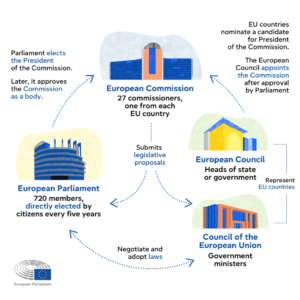Most Powerful Institutions in the European Union
The Most Powerful Institutions in the European Union are key bodies responsible for shaping, implementing, and interpreting the Union’s policies and laws.
They play a crucial role in maintaining the European Union’s political, economic, and legal framework while ensuring cooperation among its 27 member states
Most Powerful Institutions in the European Union
The European Union operates through a complex institutional framework with several powerful key institutions that hold significant power. Below are detailed descriptions of the most powerful institutions in the European Union and their influence:

The European Commission
- Role: It is the executive arm of the European Union. They are responsible for proposing legislation, implementing decisions, enforcing EU laws, managing EU policies, and ensuring the smooth functioning of the Union. Thus, it is central to the EU’s legislative, executive, and regulatory processes.
- Representation: Represent the EU in international trade negotiations and external relations.
- Leadership: Led by the President of the European Commission, supported by Commissioners from each member state.
- Current President: Ursula von der Leyen.
The European Council
- Role: This is the highest political body of the EU. It comprises the heads of state or government of the member countries. It makes high-level decisions on significant EU policies, such as foreign affairs and economic strategies. Overall, it sets the political direction and priorities of the EU but does not legislate.
- Key Powers:
- Agenda-Setting: Provides high-level guidance on the EU’s significant policies and addresses sensitive issues that cannot be resolved at lower levels.
- Crisis Management: Plays a crucial role during crises, such as economic or financial crises or geopolitical tensions.
- Appointments: Nominates key EU positions, including the President of the European Commission and the High Representative for Foreign Affairs.
- Composition: Composed of the heads of state or government of the member states, along with the President of the European Council and the President of the European Commission.
- Leadership: The President of the European Council facilitates discussions and represents the EU at summits.
- Current President: Charles Michel.
Council of the European Union (Council of Ministers)
- Role: Represent the EU governments of the EU member states. Jointly with the European Parliament, they adopt legislation and coordinate policies. Thus, they serve as a co-legislator alongside the European Parliament.
- Key Powers:
- Legislation: Adopts EU laws in coordination with the European Parliament, based on proposals from the European Commission
- Policy Coordination: Coordinates economic and fiscal policy, justice, and home affairs policies among member states.
- Budget Approval: Shares responsibility for approving the EU’s multiannual financial framework (Budget).
- Foreign Affairs: Coordinates the EU’s foreign and defense policies.
- Composition: Ministers from each member state, varying by policy area (agriculture ministers meet for agricultural policies).
- Leadership: The Presidency rotates among member states every six months, influencing the Council’s agenda and priorities.
European Parliament
- Role: The European Parliament is the EU’s directly elected legislative body, representing the citizens of the Union.
- Key Powers:
- Legislation: Shares legislative powers with the Council of the EU, with the ability to amend, approve, or reject legislation.
- Budgetary Power: Approves the EU budget, giving it influence over EU spending priorities.
- Oversight: Monitors the European Commission’s work, holds hearings and can approve or dismiss the Commission.
- Democratic Representation: Acts as the voice of EU citizens and ensures their interests are considered in policymaking.
- Composition: 705 Members of the European Parliament (MEPs), elected every five years by EU citizens.
- Leadership: Headed by a President elected by MEPs.
- Current President: Roberta Metsola.
Court of Justice of the European Union
- Role: The CJEU ensures EU law’s uniform interpretation and application across member states.
- Key Powers:
- Judicial Review: Determines whether EU institutions or member states are acting in compliance with EU treaties. Therefore, it can overrule national laws if they conflict with EU law, ensuring the superiority of EU treaties.
- Supremacy of EU Law: Resolves disputes involving EU law, including conflicts with national laws.
- Preliminary Rulings: Advises national courts on the interpretation of EU law.
- Sanctions: Can impose fines on member states for failing to comply with EU law.
- Composition: Includes one judge per member state, supported by Advocates General who provide legal opinions.
- Leadership: Led by a President elected from among the judges.
- Current President: Koen Lenaerts.
- Key Powers:
European Central Bank
- Role: The ECB manages the euro and oversees monetary policy for eurozone countries.
- Key Powers:
- Monetary Policy: Sets interest rates, maintains low inflation, and controls the money supply to ensure price stability in the eurozone.
- Banking Supervision: Monitors financial institutions to maintain financial stability.
- Crisis Management: Plays a key role in addressing financial crises and stabilizing the euro.
- Leadership: Governed by the Governing Council, composed of the ECB President and central bank governors from eurozone countries.
- Current President: Christine Lagarde
Others: European Court of Auditors



